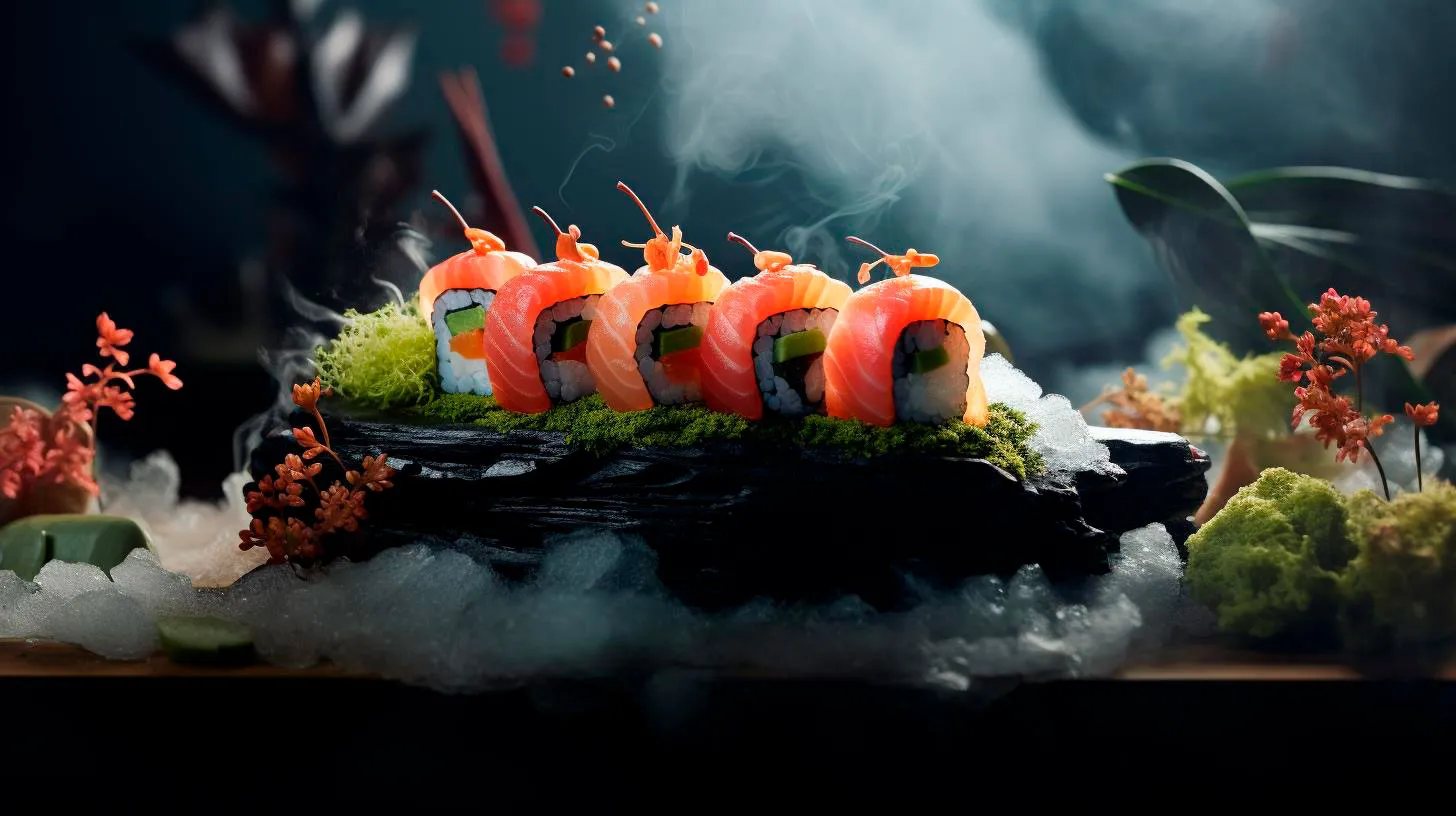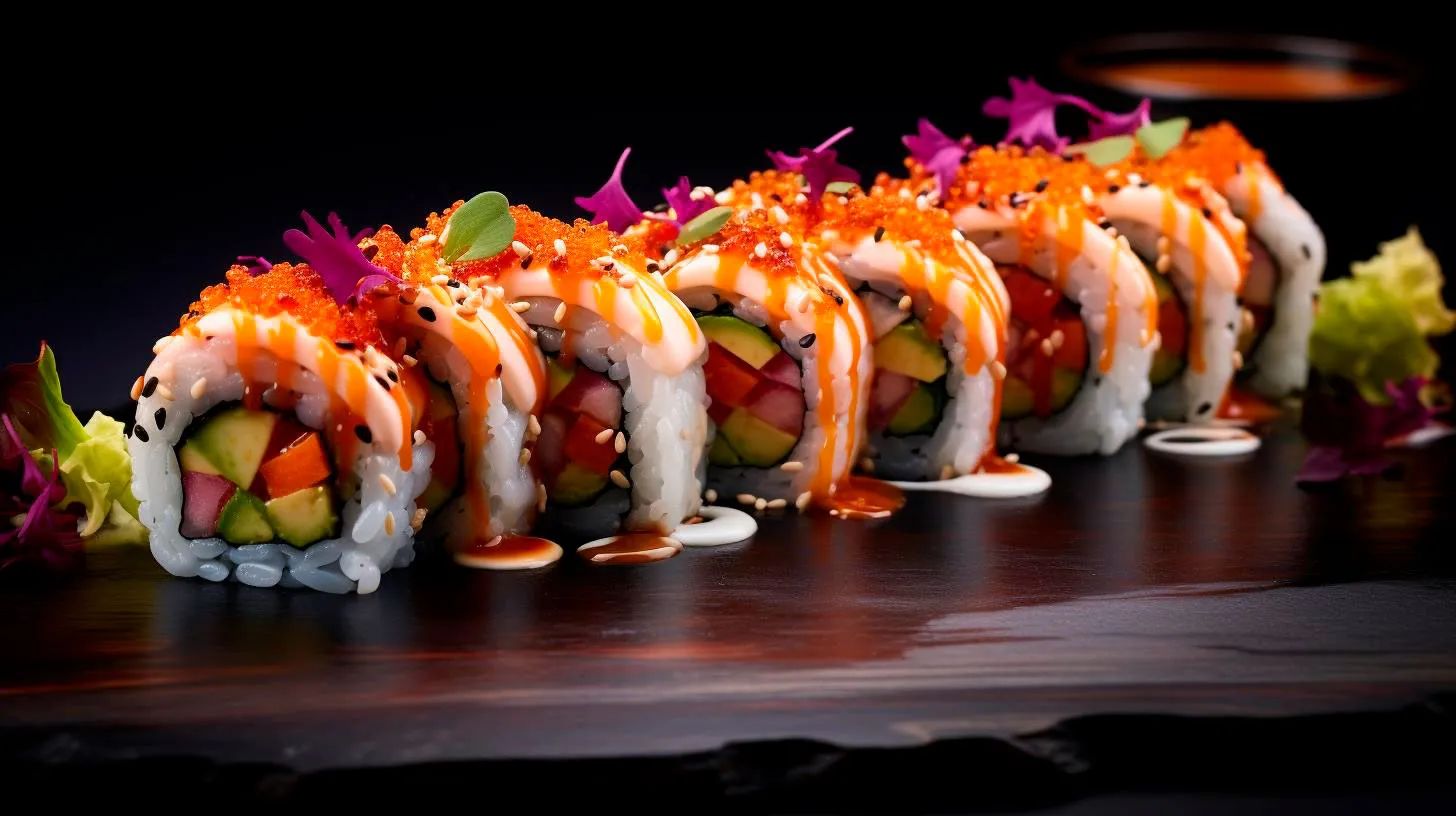Unveiling the Secrets Behind the Freshness of Sushi
In this article, we will explore the secrets behind the freshness of sushi, diving into the techniques, ingredients, and industry standards that ensure a sublime sushi dining experience.
The Perfect Ingredients
At the heart of every exquisite sushi roll lies the carefully selected ingredients. Freshness begins with the fish itself. The premium quality and freshness of the seafood play a pivotal role in the taste and overall experience of sushi. Sushi chefs source their ingredients from trusted suppliers who prioritize quality. This focus on fresh, high-grade seafood sets the foundation for exceptional sushi.
- Quality Matters: High-grade fish can bring out the unique flavors of each sushi creation. The fresher the fish, the more vibrant and enjoyable the dish becomes.
- Sustainable Practices: Many sushi restaurants take pride in sourcing their seafood sustainably. Responsible fishing practices ensure a continuous supply of fresh fish while preserving the marine ecosystem.
- Local and Seasonal: Embracing local and seasonal ingredients guarantees the freshest produce on your plate. Sushi chefs incorporate regional flavors to create unique and memorable sushi experiences.
The Art of Sushi Preparation
Sushi preparation involves skill, precision, and an unwavering commitment to freshness. From the filleting of fish to the creation of delicate rolls, every step in the process contributes to the final result.
- Freshness in Knife Skills: A sharp and well-maintained knife is essential in sushi preparation. Skilled chefs use their expertise to maximize the freshness of the ingredients by maintaining texture and minimizing damage.
- Temperature Control: Sushi chefs pay close attention to temperature as they prepare each dish. Cold ingredients are kept chilled, ensuring optimum taste and maintaining the delicate balance of flavors.
- Presentation Aesthetics: The artful presentation of sushi is not only visually pleasing but also an indicator of freshness. Chefs take pride in their creations, showcasing the natural beauty of the ingredients.
Industry Standards and Freshness Assurance
The sushi industry maintains strict standards to guarantee unparalleled freshness. Compliance with these industry guidelines ensures that the sushi you enjoy is of the highest quality.
- HACCP Guidelines: Many sushi restaurants follow the Hazard Analysis Critical Control Point (HACCP) system, which monitors and controls potential risks throughout the food preparation process. These guidelines aim to maintain the highest standards in food safety and quality.
- Frequent Fish Deliveries: To maximize freshness, reputable sushi establishments receive fish deliveries multiple times a week. This regular supply chain ensures that only the freshest fish reaches your plate.
- Collaboration with Suppliers: Sushi chefs work closely with their suppliers to stay updated on the latest catches and incorporate the freshest offerings into their menu. This collaboration helps maintain the highest quality sushi dining experience.
Key Takeaways
Now that we have unveiled the secrets behind sushi’s freshness, here are some key takeaways to remember:
- Quality ingredients, particularly fresh seafood, are paramount for exceptional sushi.
- Choose sushi restaurants that prioritize sustainable and local sourcing practices.
- The art of sushi preparation requires skill, temperature control, and meticulous attention to detail.
- Industry standards, such as HACCP guidelines, help maintain exceptional freshness and quality.
- Collaboration between sushi chefs and suppliers ensures the availability of the freshest ingredients.
Next time you indulge in a sushi feast, relish the flavors, textures, and freshness that make sushi a culinary treasure. Remember, the secrets behind sushi’s exceptional taste lie in the meticulous selection of ingredients, expert preparation, and adherence to industry standards. Enjoy every bite!
Delving into the Art of Pairing Sushi with Sake
In this article, we will explore the intricacies of this unique pairing and delve into the world of sushi and sake aficionados.
The Basics of Sushi and Sake Pairing
Sushi, the iconic Japanese dish made of vinegared rice and various toppings, offers a wide range of flavors and textures. From delicate sashimi to rich and savory rolls, sushi is a versatile cuisine that demands careful consideration when it comes to pairing it with beverages. One of the most suitable options is sake, a traditional Japanese rice wine with a complex flavor profile.
Here are some key points to consider when pairing sushi with sake:
- Balance: The key to a successful pairing is achieving a balanced harmony between the flavors of the sushi and the sake. The sake should complement the flavors of the sushi without overpowering them.
- Temperature: Sake can be served chilled, room temperature, or warmed, and the temperature can greatly influence the overall pairing experience. Lighter sushi rolls often pair well with chilled sake, while warmer sake can enhance the flavors of heartier and more robust sushi.
- Types of Sake: Just as there are different types of sushi, there are also various types of sake. From crisp and dry to sweet and fruity, the choice of sake will depend on the specific sushi being served. Exploring different sake options can open up new dimensions of flavor.
The Art of Pairing
Like any art form, the art of pairing sushi with sake requires practice, experimentation, and a bit of intuition. However, there are some general guidelines to help beginners navigate this fascinating journey:
1. Start with Lighter Sushi and Sake
When beginning your sushi and sake pairing adventure, it’s best to start with lighter sushi options such as sashimi or maki rolls. These dishes often have delicate flavors and textures, making them a perfect match for crisp and light sake varieties. Junmai or Honjozo, which are known for their subtle profiles, can be excellent choices to complement the clean taste of sashimi.
2. Experiment with Contrasting Flavors
Pairing sushi with sake doesn’t always mean finding similar flavor profiles. Sometimes, contrasting flavors can create an exciting and unexpected combination. For example, a rich and savory sushi roll might be beautifully accentuated by a fruity and aromatic sake like Ginjo. Don’t be afraid to explore different flavor pairings to find your personal favorite.
3. Consider the Umami Factor
Umami, the fifth basic taste, is known for its savory and rich flavor. Sushi often contains ingredients that contribute to this umami taste sensation, such as soy sauce, seaweed, and fish. When pairing sushi with sake, it is important to find a sake that complements and enhances the umami flavors. Look for sakes with a deeper and more robust taste, such as a Junmai or a Namazake, to accentuate the umami characteristics of the sushi.
Key Takeaways
Pairing sushi with sake can be a delightful and rewarding experience. Remember these key takeaways to craft your own perfect pairing:
- Sake can elevate the flavors of sushi when carefully paired.
- Consider the balance, temperature, and types of sake when pairing with sushi.
- Start with lighter sushi options and explore contrasting flavors.
- Take the umami factor into account when selecting the right sake.
- Experiment, have fun, and develop your own sushi and sake pairing preferences!
As you delve into the art of pairing sushi with sake, the possibilities are limitless. Whether you are a seasoned sushi lover or a sake enthusiast, this culinary exploration is sure to broaden your horizons and enhance your dining experiences. Cheers to the perfect union of sushi and sake!
Exploring the History and Cultural Significance of Sushi
The Origins of Sushi
The origins of sushi can be traced back to ancient times. In Southeast Asia, people discovered that fermenting fish with rice preserved the fish, making it an excellent source of food for long journeys. This technique was then brought to Japan around the 8th century, where it evolved into what we now know as sushi.
Initially, sushi was prepared by wrapping fermented fish in rice and allowing it to ferment further. This method, known as narezushi, was popular among the commoners during the Muromachi period (14th to 16th century). However, it wasn’t until the Edo period (17th to 19th century) that sushi started to resemble its modern form. During this time, a method called haya-zushi emerged, where the fermentation process was significantly reduced, resulting in a fresher taste.
The Cultural Significance of Sushi
Sushi has become an integral part of Japanese culture and society. It is not just a meal but also an art form that reflects the country’s traditions and values. Here are some key reasons why sushi holds such cultural significance:
- Seasonality: Sushi chefs pay great attention to the changing seasons, sourcing only the freshest and most seasonal ingredients. This emphasis on seasonality ensures that sushi is always enjoyed at its peak flavor.
- Presentation: Sushi is not only about taste but also about visual appeal. Sushi chefs meticulously plate each piece, creating a work of art that pleases both the eyes and the palate.
- Discipline and Precision: Making sushi requires years of training and dedication. Sushi chefs undergo rigorous apprenticeships and strive for perfection in every aspect of their craft, from knife skills to ingredient selection.
- Respect for Ingredients: Sushi elevates the natural flavors of its ingredients. The simplicity of the dish allows the quality of the fish, rice, and other components to shine, promoting a deep appreciation for the ingredients themselves.
Key Takeaways
Sushi’s journey from a preservation method to an iconic international cuisine speaks volumes about its enduring appeal. Here are the key takeaways when exploring the history and cultural significance of sushi:
- Rich History: Understanding the origins of sushi helps us appreciate its roots and evolution over time.
- Cultural Appreciation: Sushi provides a gateway to Japanese culture, showcasing traditions, artistry, and values.
- Seasonality and Presentation: Sushi’s emphasis on seasonality and visual appeal adds depth to the dining experience.
- Discipline and Respect: The dedication and respect shown by sushi chefs towards their craft and ingredients are remarkable.
- Global Impact: Sushi’s worldwide popularity highlights its ability to transcend cultural boundaries and bring people together.
In conclusion, sushi is more than just a meal; it is a representation of Japanese history, culture, and art. Its journey from a preservation technique to an internationally acclaimed cuisine speaks volumes about its significance. Whether you’re enjoying traditional nigiri or exploring creative sushi rolls, every bite allows you to delve deeper into the rich tapestry of sushi’s past and present.
Deciphering the Science of Umami in Sushi Flavors
In this article, we will delve into the science behind umami in sushi flavors, exploring its characteristics and uncovering the secrets to experiencing it at its finest.
The Science Behind Umami
Umami, a word derived from the Japanese term for “pleasant savory taste,” was first identified in 1908. It is considered the fifth basic taste alongside sweet, salty, sour, and bitter. The discovery of umami was attributed to Japanese chemist Kikunae Ikeda, who identified the unique taste found in foods like seaweed and kombu. Since then, umami has gained recognition as a distinct taste that adds richness and depth to various culinary creations, including sushi.
Umami taste is a result of specific amino acids, most notably glutamate and ribonucleotides, encountered in certain foods. These amino acids interact with taste receptors on our tongues, sending signals to our brains that interpret the taste as umami. This scientific explanation provides a solid foundation for understanding the unique flavor profile found in sushi dishes.
Unraveling Umami in Sushi
When it comes to sushi, umami can be found in different ingredients, preparation methods, and even the combination of flavors. Here are some key factors that contribute to the umami experience in sushi:
- Fish Selection: The type and freshness of the fish used in sushi greatly influence the umami flavor. Fatty fish such as salmon and tuna are known to have higher levels of natural umami compounds, enhancing the overall taste.
- Seaweed: Nori, a type of dried seaweed commonly used to wrap sushi rolls, is rich in glutamate, the primary umami compound. Its inclusion in sushi elevates the umami flavor, complementing other ingredients.
- Fermentation: Fermented ingredients like soy sauce, miso paste, and vinegared rice not only enhance the taste of sushi but also contribute to the umami experience. These fermented elements often undergo enzymatic processes that create additional umami compounds.
The Benefits of Umami
Understanding and appreciating umami in sushi flavors goes beyond simply enhancing our taste buds. Here are some noteworthy benefits of embracing this fifth taste:
- Enhanced Palate: Recognizing umami enables us to identify complex flavors, allowing a more nuanced experience as we savor sushi dishes.
- Reduced Sodium Intake: Umami-rich ingredients can contribute to reducing the need for excessive salt in sushi preparation, promoting a healthier alternative without compromising taste.
- Increase Satisfaction: The presence of umami in sushi leads to a more satisfying dining experience, both in flavor and satiety. This can help promote portion control, as the umami taste provides a sense of fullness.
Key Takeaways
As sushi aficionados, it is essential to recognize and appreciate the science behind umami flavors. Understanding the role of umami-rich ingredients such as fish, seaweed, and fermentation techniques can open up a world of culinary possibilities. Embracing umami not only enhances our dining experiences but also allows us to develop a deeper appreciation for the art of sushi-making. So, the next time you indulge in a sushi feast, take a moment to savor the rich umami taste that elevates this beloved cuisine to new heights.


